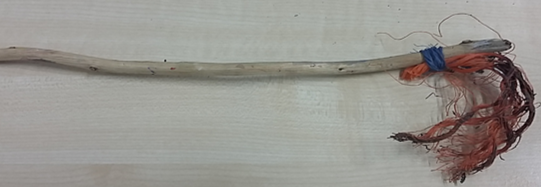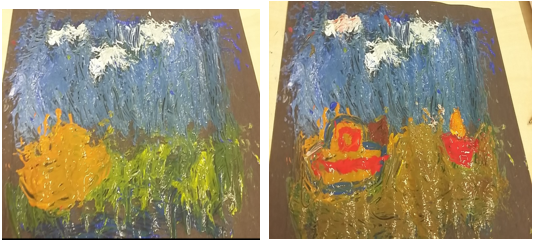I found today’s dance and art session the most intriguing so far as both concentrated on using child-centred approaches which opened up a multitude of possibilities and results. Firstly, in dance we amalgamated each group’s dance into one class dance while incorporating the theme of Halloween as shown in a screenshot below:
Linking back to Silverstein, L (2010) “evolving objectives” in art concept, this session successfully achieved this as discrete movements were brought together over several dance sessions to put into one class performance.
This dance was constructed by putting together everyone’s ideas which Cone (2009) supported as she realised the importance of allowing children to “express their individual identity and collectively cooperate to find a way to recognise everyone’s needs.” This was embedded in our dance throughout as everyone had the opportunity to induce their own personality into the performance. It also links back to a prior dance session where each individual lead the class in repeating one dance move depending on how they interpreted the music.
This session further provided a useful overview of how to construct a class performance, adapting it to children’s needs like we saw in a video featured in the lecture whereby a young boy’s interest in dance was sparked when links could be made using topics that he found interesting, eg. sport. Cone (2009) expands on this as she found linking dance to sport encouraged good sportsmanship as children often displayed one victorious team in the end but would also congratulate the other team which is an important lesson for children to learn.
I realise I am beginning to enjoy dance more with each session, primarily because I am not singled out to perform but rather the whole class or groups perform together which makes introverted people such as myself more comfortable with performing. This is also how I can adapt dance to suit different children’s needs, identifying what aspects they are comfortable with and trying to magnify or encourage this.
Furthermore, the art session encompassed using paintbrushes that children could construct with any material they may find, creating varied and interesting marks. Below, I have displayed the paintbrush I selected.
I learned how using a normal paintbrush automatically forces children to care about the accuracy of their creations and how this activity takes that concern away.
A painting was then dictated for our own creative replications using a palette that consisted of only primary colours.
This was truly a great activity as children are free to create their own interpretations of what was described and achieve the concept of creative flow, described by Csikszentmihalyi, (1996). “A highly rewarding state of mind which involves intense concentration, a sense of deep engagement and personal agency with a task, and an apparently seamless flow of ideas and thoughts” (Education Scotland, 2013, p.8). This is a key concept for teachers to be able to help children to experience, and can be facilitated through an environment that fosters creativity, described by Grainger and Barnes (2006) in Newton, (2012, p.14) as “relaxed, supportive, serious but with a touch of playfulness, and [should] offer a mix of individual and cooperative activity.”
I also learned how the colour wheel is unnecessary as it is a very mechanistic means of understanding colours as children will inevitably discover how colours are made by mixing them together.
One drawback to this activity and art in general I find is that children can easily become dissatisfied with their own work if they work alongside others and subconsciously compare their work to the work of others. This also became a significant discussion within the final visual art session, as it was highlighted that direct comparisons between differing qualities of work should not be made. This also relates back to the first session of art where we discovered the falseness of the phrase “I cannot draw”. To counteract this, McAuliffe (2007) suggests to establish a solid foundation during KS2 in order for pupils to be satisfied and have confidence that their work is of a good level. Another way of maintaining this positive attitude as further suggested by McAuliffe (2007) is to keep a folio of work, so as children and future art educators can view their past achievements and view their development and successes. As an art educator, it is important that I establish and continue to emphasise that everyone has the ability to draw in order for each child to value their own piece of artwork.
References
Csíkszentmihályi, M (1996) Flow and the Psychology of Discovery and Invention [Online] Available: http://www.bioenterprise.ca/docs/creativity-by-mihaly-csikszentmihalyi.pdf [Accessed: 23 December 2016].
Education Scotland (2013) Creativity Across Learning 3 – 18 [Online] Available: http://www.educationscotland.gov.uk/Images/Creativity3to18_tcm4-814361.pdf [Accessed: 7 December 2016].
McAuliffe, D (2007) Foundation and Primary Settings. In: Mark O’Hara (eds) Teaching Art and Design 3 – 11 London: Continuum
Newton, L (2012) Creativity for a New Curriculum: 5 – 11 [Online] London and New York: Routledge. Available: https://books.google.co.uk/books?id=7gUhcK4hiQ8C&printsec=frontcover&dq=creativity+in+scottish+primary+education&hl=en&sa=X&ved=0ahUKEwiMlqaTwu_QAhUrDcAKHdLXC1wQ6AEIKjAB#v=onepage&q&f=false [Accessed: 12 December 2016].
Silverstein, L and Layne, S (2010) Defining Arts Integration The John F. Kennedy Centre for the Performing Arts.
Theresa Purcell Cone (2009) Following Their Lead: Supporting Children’s Ideas for creating dances, Journal of Dance Education [Abstract, Online] Available: http:/dx.doi.org/10/1080/15290824.2009.10387390 [Accessed: 6/10/16].



